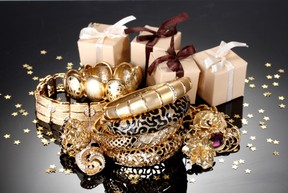Many jewelers have a variety of pieces on hand, and their goal is to sell jewelry at the highest price. Even if you find the right piece, keeping your wallet or purse intact is difficult if you fall in love with a ring or necklace without quite understanding all the options that accompany these types of purchases.
1. The recipient
First and foremost, you need to understand the person for whom you are buying the jewelry. You should know if the person prefers silver to gold or gold to silver. Knowing whether that person likes simple or ornate jewelry will also ensure you match your gift to his or her personal sense of style.

Of course, if you are purchasing for yourself, you should attempt to find a jeweler that carries enough inventory that matches your style. If you find someone with only a smattering of pieces that you like, you can find yourself compromising or buying in excess in order to get something you like.
2. Metals
Some people prefer simple jewelry that consists primarily of gold, silver, or platinum. For instance, a gold necklace can consist of just a chain. In these instances, you should determine what type of gold the jewelry comes in. In keeping with the example of a gold necklace, you might consider a variety of styles, such as herringbone, cable link, or the classic rope.
Similarly, you need to consider what type of precious metal you need because there are many too choose from.
- silver
- gold
- white gold
- platinum
Note: white gold is not actually gold. Instead, it is a mix of precious metals that include gold as well as elements of silver or nickel. In many instances, white gold also includes an alloy called palladium. When purchasing any type of metal jewelry, you should determine how to care for it. For instance, white gold or platinum can tarnish over time. If it tarnishes, you might need to have it re-polished.
3. Real-world versus online

Simply put, a real-world jeweler must pay for overhead that includes leasing a building. If you find a reputable online dealer, the prices are often lower even though the jewelry is the same quality as what you would find in a jewelry store. This adjustment in price stems from a lack of overhead, and the resulting savings can be significant.
For instance, savings at an online jewelry store can be upwards of 50 percent. That said, some of the prices of some reputable dealers reach 70 percent or higher. Again, this is because online boutiques like Revelation Boutique can afford to pass savings to gift buyers because there is no lease for a commercial building.
4. Quality
When you are purchasing metal, the metal will be marked with the overall purity. For instance, 14K gold will have "14K" etched or stamped on the reverse side of the surface. If you are buying a ring, you can find the etching on the inside of the ring that will touch the wearer's finger. The different purity ratings are as follows.
Gold
- 10K: gold content equals 41 percent
- 14K: gold content equals 58 percent
- 18K: gold content equals 75 percent
- 24K: gold content equals 100 percent
Silver
- sterling: content equals 92.5 percent
- pure silver: content equals 99 percent
5. Stones
Your jeweler should have a variety of stones in stock. Some of the stones that convey subtle elegance include some of the following classic stones.
- obsidian
- pearls
- turquoise
- onyx
6. Certification
Any time you purchase jewelry, you should be able to either rely on the quality etching on the metal or the certification of the gemstone. A certification showing the grade of a gemstone, for instance, will help you insure it for the right amount.
7. Delivery
If you purchase online, you should look for a dealer that offers a variety of shipping options. After all, if you are purchasing a piece as a gift, you want it to arrive before that special day.





 10 Things You Need To Have Clean and Spotless Clotheson 10/28/2021
10 Things You Need To Have Clean and Spotless Clotheson 10/28/2021
 10 Business Ideas For Newbies That Will Thriveon 10/27/2021
10 Business Ideas For Newbies That Will Thriveon 10/27/2021

Comments